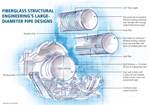Making continuous composite pipes
A description of the continuous filament winding process.
The continuous filament winding process was invented by Agnar Gilbu of Sandefjord, Norway, using machinery developed by Danish inventor Frede Hilmar Drostholm. Gilbu took his production method to Vera Fabrikker (at that time a subsidiary of Sandefjord-based global paint supplier Jotun) as a possible use for their resin. Production started in 1965, but initially the process was used only to make tanks. In 1968, Vera Fabrikker supplied the first pipes to customers. In Sandefjord, Veroc Technology AS was established in 1977 as a joint venture between Vera Fabrikker and Owens Corning (Toledo, Ohio). When Owens Corning went through its asbestos-related bankruptcy in 2001, Amiantit (Dammam, Saudi Arabia), a long-time Veroc customer, acquired Veroc, which had by then been renamed Flowtite Pipe and Tank AS.
The ingenious process involves a cantilevered, horizontal rotating mandrel system. Customizable to a range of pipe diameters, the mandrel is made up of longitudinal aluminum beams fitted with small outward-facing roller bearings, a series of discs (sized to the pipe to be produced) that support the beams and a steel “band,” or endless loop. As the mandrel rotates, the steel band, which is about 2 inches/51 mm wide, is wound over the beams by a placement head on the mandrel’s supported end. As it is wound, the band also is pulled and, therefore, moves over the roller bearings in the axial direction, advancing toward the other (open) end of the mandrel. At that end, an exit head directs the band back through the mandrel’s core to the supported end, where the placement head directs it onto the mandrel again. In this way, the wound band forms a continuously advancing, smooth tool surface onto which the pipe materials are applied, via filament winding heads on either side. The wound pipe is pulled along by the advancing band through a heated zone near the mandrel’s open end to cure. Then the cured pipe exits the mandrel system, and the continuous pipe is cut to the desired length for transport to the project site. Some manufacturers can produce more than 30m/hr (98 ft/hr), and the technology can currently fabricate pipe up to 4m/13 ft in diameter.
To see a continuous filament winder in action, visit YouTube for several videos, including this one produced by large-pipe fabricator Technobell London (Harrow, Middlesex, U.K.): http://www.youtube.com/watch?v=YAdwxIELLDU&feature=player_embedded#at=220.
Related Content
-
TU Munich develops cuboidal conformable tanks using carbon fiber composites for increased hydrogen storage
Flat tank enabling standard platform for BEV and FCEV uses thermoplastic and thermoset composites, overwrapped skeleton design in pursuit of 25% more H2 storage.
-
Large-format 3D printing enables toolless, rapid production for AUVs
Dive Technologies started by 3D printing prototypes of its composite autonomous underwater vehicles, but AM became the solution for customizable, toolless production.
-
PEEK vs. PEKK vs. PAEK and continuous compression molding
Suppliers of thermoplastics and carbon fiber chime in regarding PEEK vs. PEKK, and now PAEK, as well as in-situ consolidation — the supply chain for thermoplastic tape composites continues to evolve.
















